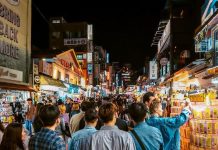Sure, you can turn up at the foot of Mt Kilimanjaro with nothing but a song in your heart and a pocket full of dreams. But you’re going to be in for a bit of a shock.
- 20 best trails for hiking around the world
- 11 hardest mountains to climb in the world
- Top ski resorts in Hokkaido — Top 5 places & best ski resorts in Hokkaido
- Himalayan treks for beginners — 8 essential tips you should keep in mind when trekking in the Himalayas
- Kota Kinabalu travel blog — The fullest Kota Kinabalu travel guide for first-timers
Written by James Shackell.
Without at least a little pre-trip training, or a good basic level of fitness, trekking is hard work. It’s often hard work anyway. The toll for a great trek is paid in sweat. Sore calves and aching quads are your badges of honour. The trade off? Some of the most untouched, pristine and jaw-dropping scenery on the planet. And you know what: the more you train, the easier it is. Honest.
But you don’t have to be an Iron Man to climb to Everest Basecamp or reach the top of Mt Toubkal. Far from it. Trekking is available to anyone, you just have to be sensible and train for it. And to that end, here our some of our top tips for your pre-trek prep.
1. Walk the walk
This may seem like an obvious one, but you’d be surprised how many people don’t do it. The best way to prepare for a long walk? Do long walks. Preferably starting small and building up slowly to the actual length you’ll be trekking on the trip. At the beginning, leave a day in between each walk. But as you improve, try to do back-to-back sessions each day – it’ll help you improve for the relentless nature of a ten-day trek, where you won’t have the luxury of rest days. Our recommendation is to be able to walk 4-6 hours comfortably before you leave.
2. Work those legs

Although there’s no substitute for long walks, any leg-based cardio is going to help you prepare. Soccer, football, squash and swimming are all great, but cycling will help build your leg muscles faster. If you’re more of a gym junky, mix up cycling sets with weighted squats and lunges. Stair climbing is also a good one for building up calves and quads. If your building has a lift – try skipping it every day and take the stairs instead. Run up and down them a few times during your lunch break. Incidental exercise adds up.
3. Step correct
It might seem strange, but you may be walking wrong. This doesn’t matter if your usual route is the couch to the fridge, but over 150 kilometres of alpine terrain the tiniest defect in your stride can grow into a very painful problem. Make sure you’re touching the ground heel first, rolling onto your toe, which you use to propel you for the next step. This will help avoid the risk of shin splints and tendon pulls. Walk with your head up, not slouched forward, and try to keep your shoulders level.
4. Mix up the terrain

You won’t be hiking on level tracks or asphalt, so it doesn’t make sense to train on uniform, flat surfaces. Try and mimic the conditions of your trek. If it’s Everest or Kili, you’ll be looking for steep, rocky terrain or loose shale. If it’s Kokoda, try to find muddy paths covered with roots and leaf mould. It’s all about preparing your feet, ankles and knees for the kind on stress they’ll experience on the trip.
5. Take a backpack

On most of our trekking trips, you won’t be carrying your main pack, but you’re going to be carrying a small day pack up and down the mountains with essentials like rain gear, camera, snacks and water. So when you’re training, make it challenging: bring your backpack along. You can fill it with Gatorade and chocolate if you want, as long as there’s a solid weight on your back. If you really want to push it, try loading your pack a little heavier than you’re planning to on the trip – it’ll make the eventual trek feel like a walk in the park.
6. Fuel correctly
Hydration and food are crucial during a trek, and in preparation for one. Nuts, jerky, dried fruit, oat bars and chocolate are all good quick sources of energy and protein. The good news is that alpine streams are usually a great source of fresh water (and it’ll taste a whole lot better than the filtered stuff you’re used to back home). During your training, make sure to eat ‘on the go’ so you’re body can get used to digesting during strenuous exercise.
7. Footwear is key

Underestimate your feet at your peril. They’re the most crucial body part on your trek and it doesn’t take much to look after them. First, invest in a good-quality set of hiking boots, preferably with good water resistance and plenty of support and ventilation. Wear them in the months leading up to the trek. Take them on every training run. It’ll help wear them in and avoid blisters. Next, socks. Buy some dedicated hiking socks (usually a nylon/wool blend) that will keep out the moisture. Wear two pairs while walking to further reduce the chance of blisters.
























































